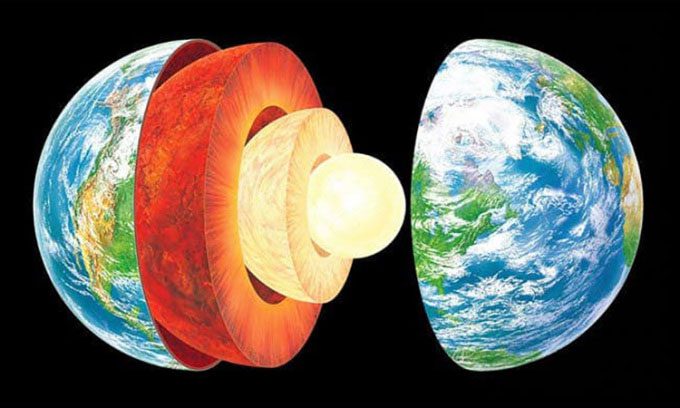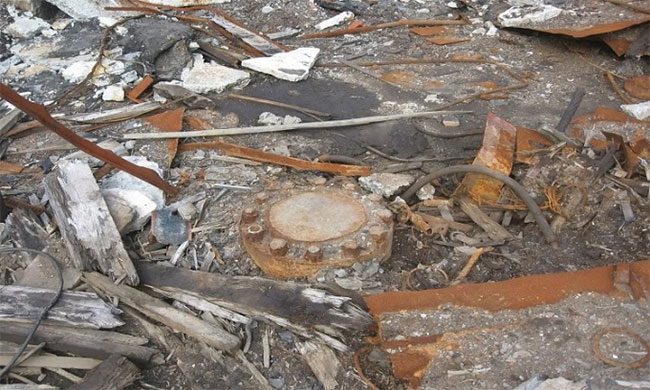To penetrate the crust, mantle, and core of the Earth, a drill made from specialized materials capable of withstanding enormous heat and pressure is required.
Although humans have never drilled through the Earth, scientists can make some predictions about this process based on data from other drilling projects. The diameter of the Earth is 12,756 km. Therefore, the process of drilling through the planet requires a gigantic drill and decades of work.

Simulation of the layers of the Earth. (Image: Victoria Museum).
The first layer to drill through is the Earth’s crust, which is about 100 km thick, according to the United States Geological Survey (USGS). Atmospheric pressure increases as the drill goes deeper underground. For every 3 meters of rock, there is approximately 1 atmosphere of pressure—equal to pressure at sea level, according to Doug Wilson, a geophysicist at the University of California, Santa Barbara.
The deepest artificial hole currently is the Kola Superdeep Borehole in Russia, which reaches a depth of 12.2 km. At the bottom of this hole, the pressure is 4,000 times greater than at sea level. Scientists took nearly 20 years to achieve this depth, and even then, they were still over 80 km away from the next layer of the Earth, the mantle, which is a solid, dark rock layer approximately 2,800 km thick that governs tectonic plates.
The boundary between the mantle and the Earth’s crust is referred to as “Moho”. Scientists first attempted to drill to this point in the deep sea during the 1950s and 1960s with the Mohole Project but were unsuccessful.
A significant issue is that the hole created in the planetary drilling mission will collapse unless drilling fluid is continuously pumped into it. When drilling oil wells and deep-sea wells, this fluid is a mixture of mud containing heavy minerals, such as barite. Wilson explains that the weight of the fluid helps balance the pressure inside the hole with the pressure of the surrounding rock, preventing the hole from collapsing.
The drilling fluid also has two other functions: cleaning the drill bit to prevent sand and gravel from sticking to the machinery and helping to reduce temperature, although keeping the drill bit cool at the innermost layers of the Earth is nearly impossible. For example, temperatures in the mantle can reach up to 1,410 degrees Celsius. According to Wilson, stainless steel would melt, so the drill bit needs to be made from expensive specialized alloys, such as titanium.

The Kola borehole was capped in 2012. (Image: Wikimedia)
After penetrating the mantle, the drill will eventually reach the Earth’s core at a depth of about 2,900 km. The outer core consists mainly of liquid nickel and iron, extremely hot with temperatures ranging from 4,000 to 5,000 degrees Celsius, according to the California Academy of Sciences. Drilling through this molten mixture will be particularly challenging.
“This process will pose a series of problems,” says Damon Teagle, a geochemist at the University of Southampton. The super-hot outer core could melt the drill bit unless cold water is pumped down. Then, after drilling 5,000 km, the drill will reach the inner core, where the pressure is so great that despite the scorching temperature, the nickel and iron remain solid. Teagle notes that the drill would have to withstand a pressure of about 350 gigapascals, which is 350 million times atmospheric pressure.
Throughout the process, the drill will be pulled down to the core by Earth’s gravity. At the center of the core, gravitational force will be similar to that in orbit, resulting in a weightless state. The reason is that the gravitational pull of Earth’s mass will be equal in all directions, Wilson explains.
According to Teagle, if all these obstacles are overcome, the biggest problem upon reaching the midpoint is that there is still a long way to go to the other side. As the drill continues toward the other side of the planet, the gravitational pull will change based on the drill’s position, pulling it back toward the core. The drill will have to fight against gravity as it moves up towards the surface, through the outer core, the mantle, and the crust, in contrast to its downward journey.





















































